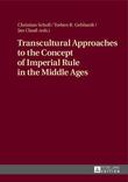Explore

Transcultural Approaches to the Concept of Imperial Rule in the Middle Ages
0 Ungluers have
Faved this Work
Login to Fave
During the Middle Ages, rulers from different regions aspired to an idea of imperial hegemony. On the other hand, there were rulers who deliberately refused to be «emperors», although their reign showed characteristics of imperial rule. The contributions in this volume ask for the reasons why some rulers such as Charlemagne strove for imperial titles, whereas others voluntarily shrank from them. They also look at the characteristics of and rituals connected to imperial rule as well as to the way Medieval empires saw themselves. Thus, the authors in this volume adopt a transcultural perspective, covering Western, Eastern, Northern and Southern Europe, Byzantium and the Middle East. Furthermore, they go beyond the borders of Christianity by including various caliphates and Islamic «hegemonic» rulers like Saladin.
This book is made open access as part of the Knowledge Unlatched OGeSoMO
This book is made open access as part of the Knowledge Unlatched OGeSoMO
This book is included in DOAB.
Why read this book? Have your say.
You must be logged in to comment.
Rights Information
Are you the author or publisher of this work? If so, you can claim it as yours by registering as an Unglue.it rights holder.Downloads
This work has been downloaded 375 times via unglue.it ebook links.
- 88 - pdf (CC BY-ND) at OAPEN Library.
- 191 - pdf (CC BY-ND) at Unglue.it.
Keywords
- Asian history
- Byzantium
- Charlemagne
- Europe
- History
- Humanities
- imperial
- KUnlatched
- Middle Ages
- Middle East
- Middle Eastern History
- Regional & national history
- Saladin
- thema EDItEUR::N History and Archaeology::NH History::NHG Middle Eastern history
Links
DOI: 10.3726/978-3-653-05232-9Editions



